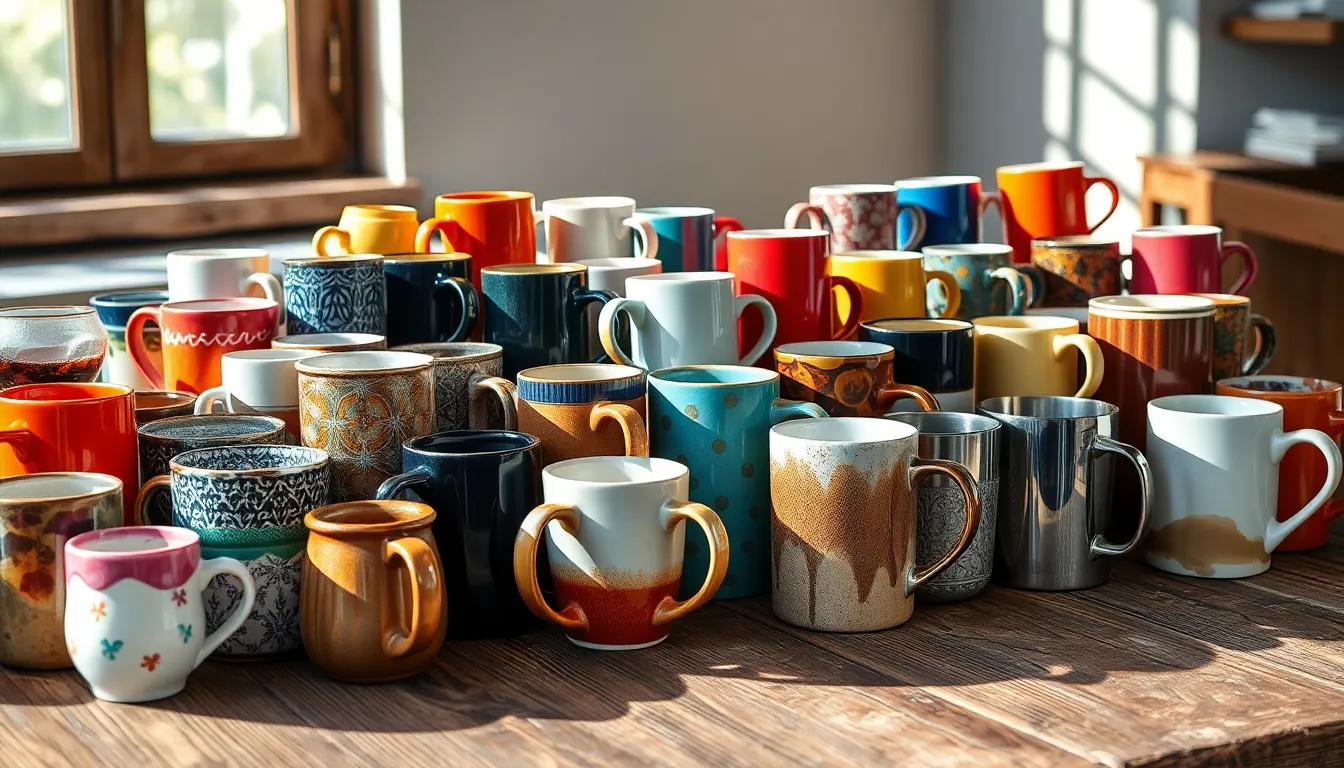Ever wondered what your favorite coffee mugs are actually made of? That morning vessel holding your precious caffeine isn’t just a simple container—it’s a carefully crafted piece combining art, science, and functionality.
Coffee mugs come in a surprising variety of materials, each offering unique benefits for your daily brew. From classic ceramic and porcelain to modern stainless steel and glass, your choice of mug material affects everything from heat retention to taste. Understanding these differences can transform your morning coffee ritual and help you select the perfect mug for your exact needs.
The Wide World of Coffee Mug Materials
Coffee mugs come in a diverse array of materials, each offering unique benefits for your morning brew. Material selection impacts everything from heat retention to flavor preservation and even the overall aesthetic of your coffee experience.
Ceramic and Porcelain
Ceramic mugs represent the most common option found in households worldwide. These classic vessels are crafted from clay that’s shaped and fired at high temperatures, creating a durable, non-porous surface. Traditional ceramics maintain heat effectively while imparting no additional flavors to your coffee.
Porcelain mugs elevate the ceramic concept with finer materials and higher firing temperatures. The result is a thinner, more elegant vessel that’s surprisingly strong even though its delicate appearance. Many coffee enthusiasts prefer porcelain for its superior heat retention and pristine white color that showcases the rich hues of different coffee varieties.
Stoneware and Earthenware
Stoneware mugs offer exceptional durability with their dense, opaque bodies fired at temperatures between 2150°F and 2330°F. These hearty vessels often feature unique, rustic aesthetics with speckled finishes or earthy glazes. Coffee shops frequently choose stoneware for its rugged charm and remarkable ability to keep beverages hot.
Earthenware brings a more artisanal quality to coffee mugs with its porous clay body fired at lower temperatures (1740°F to 2120°F). These mugs typically require glazing to prevent liquid absorption but reward users with distinctive, handcrafted appearances. Many pottery enthusiasts create custom earthenware mugs, each with unique characteristics that can’t be mass-produced.
Glass and Crystal
Glass mugs offer a transparent window into your coffee, allowing you to appreciate the visual aspects of your brew. Double-walled glass designs provide excellent insulation while creating a striking floating effect. Specialty coffee shops often serve their most visually appealing drinks in glass to showcase layered creations.
Crystal mugs represent a luxury option with exceptional clarity and brilliance. These sophisticated vessels elevate the coffee drinking experience but require careful handling due to their fragility. Crystal’s thermal properties don’t match insulated alternatives, making these mugs better suited for special occasions rather than everyday use.
Metal Options
Stainless steel mugs excel in durability and heat retention, making them ideal for outdoor adventures or office environments. These practical containers won’t break when dropped and often include features like vacuum insulation to keep drinks hot for hours. Modern designs overcome earlier metallic taste concerns with food-grade materials that preserve coffee’s natural flavors.
Copper mugs introduce a vintage aesthetic while providing excellent thermal conductivity. The metal transfers heat quickly, keeping beverages at consistent temperatures. Many copper mugs feature interior linings of stainless steel or tin to prevent metal reactions with acidic coffee.
Alternative Materials
Silicone components frequently appear in travel mugs as lids, sleeves, or collapsible sections. This flexible, heat-resistant material creates spill-proof seals and comfortable gripping surfaces. Completely silicone mugs can fold flat for storage, making them convenient for camping or backpacking.
Wooden mugs offer a rustic, natural option with excellent insulation properties. Traditional designs use single pieces of carved wood, while modern versions typically incorporate metal or glass liners with wooden exteriors. Coffee enthusiasts appreciate wooden mugs for their organic warmth and connection to traditional craftsmanship.
Ceramic Coffee Mugs: The Classic Choice
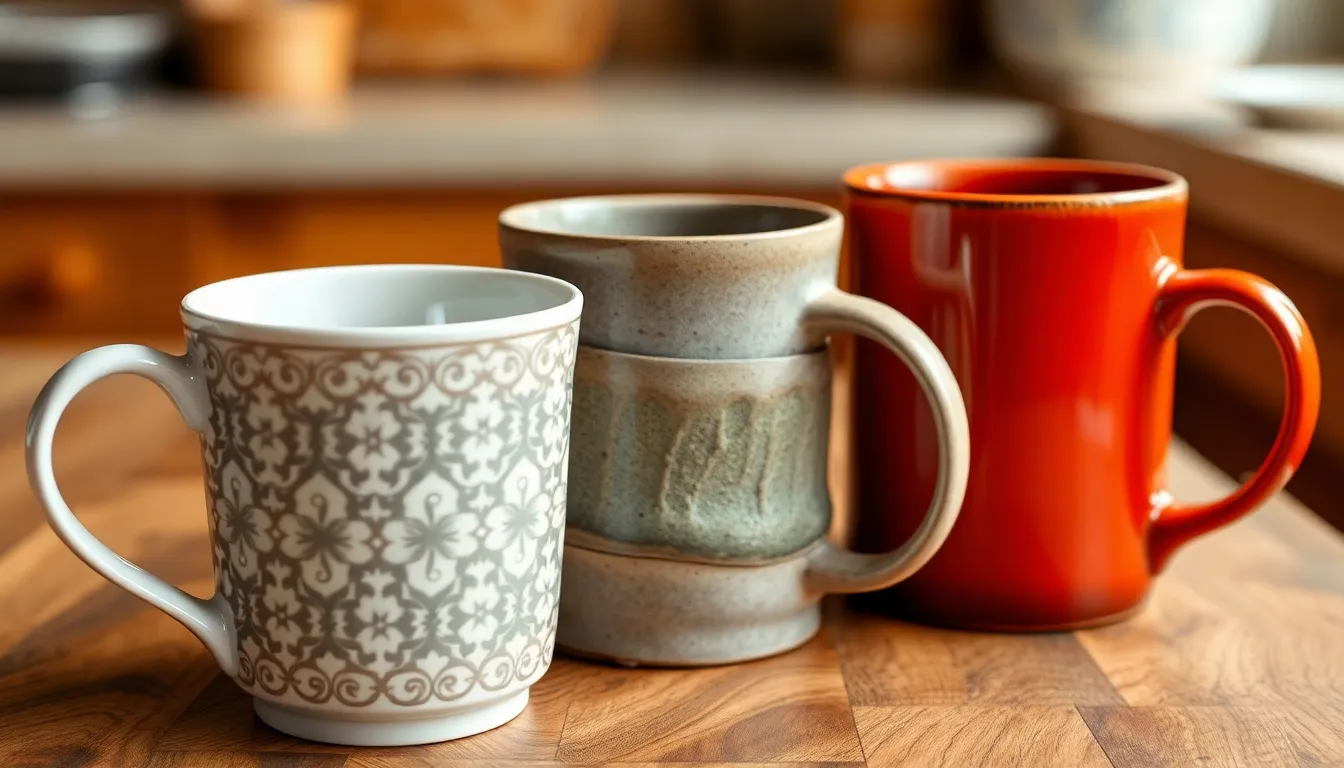
Ceramic mugs represent the quintessential coffee vessel, combining tradition with practicality. These popular containers are crafted from clay that’s shaped and fired at high temperatures to create a durable material perfect for daily use. Ceramic’s excellent heat retention properties keep your coffee warmer longer, while its versatile surface accepts glazes and decorations that transform simple mugs into personalized works of art.
Porcelain and Fine China Mugs
Porcelain mugs offer an elegant alternative to standard ceramics, distinguished by their translucent appearance and refined aesthetics. Made from kaolin clay and fired at extremely high temperatures, these mugs feature thinner walls that showcase intricate patterns and vibrant colors. Their excellent insulation properties ensure your beverage stays warm throughout your morning routine. Porcelain mugs typically contain no harmful substances like lead or BPA, making them a safe choice for everyday use. The primary drawbacks include their relatively heavier weight compared to plastic or metal alternatives and higher price points reflecting their quality craftsmanship.
Stoneware Mugs for Daily Use
Stoneware mugs excel in durability and practical function, making them ideal companions for your daily coffee ritual. Fired at higher temperatures than regular ceramic but generally lower than porcelain, stoneware develops a dense, non-porous quality that resists chipping and handles temperature changes with ease. These robust mugs maintain heat effectively, keeping your coffee hot while you tackle morning tasks. Their distinctive rustic appearance adds character to your kitchen collection, with each piece often displaying unique variations in texture and finish. Stoneware’s sturdy construction withstands the rigors of dishwashers and microwaves, proving its value as a long-lasting investment for coffee enthusiasts.
Glass Coffee Mugs: Elegant and Transparent
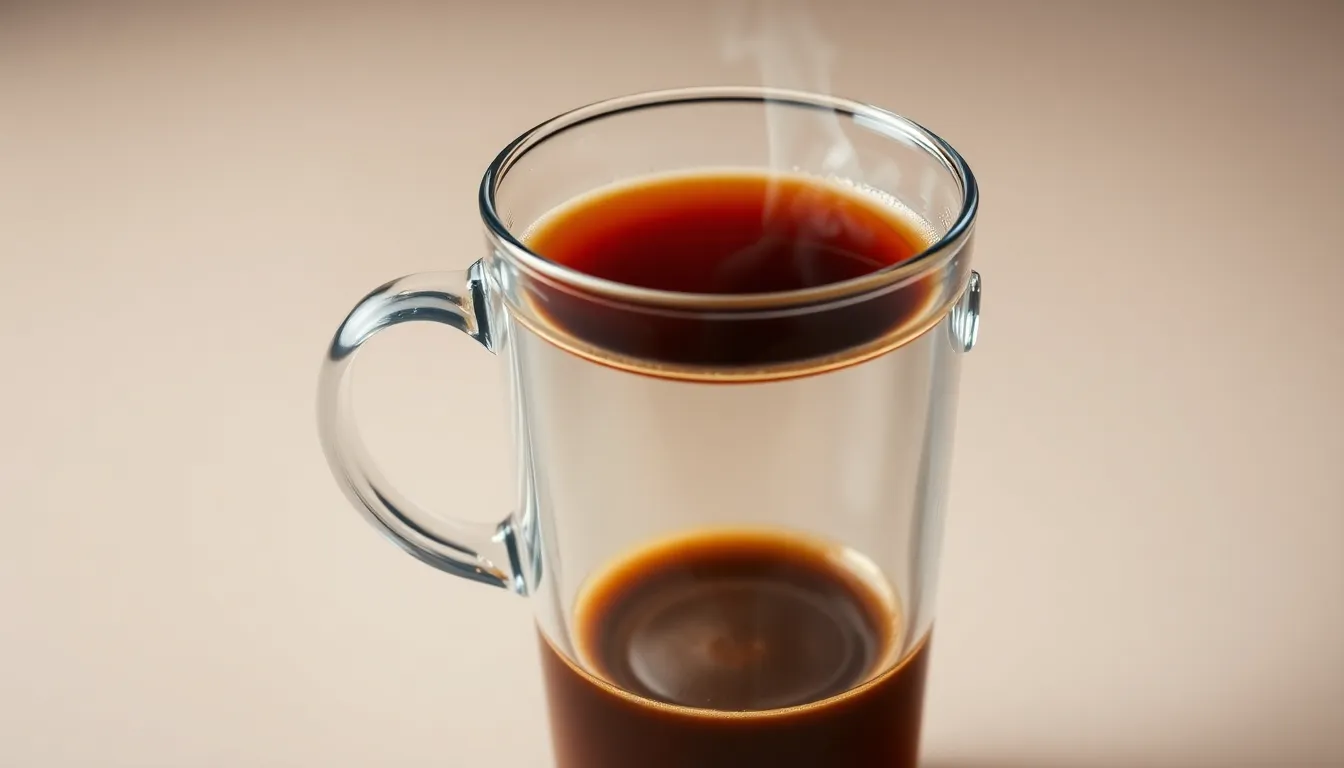
Glass coffee mugs offer a unique visual experience, allowing you to appreciate your coffee’s color and clarity. Their transparency creates an elegant presentation that ceramic and metal mugs simply can’t match.
Borosilicate Glass for Heat Resistance
Borosilicate glass stands out as the premium material for heat-resistant coffee mugs. This specialized glass contains boron trioxide which creates a strong molecular structure that withstands temperature extremes without cracking. Unlike regular glass, borosilicate won’t shatter when hot coffee meets a cold mug, making it perfect for your daily brew. Many coffee enthusiasts appreciate the peace of mind that comes with knowing their glass won’t crack unexpectedly during temperature changes.
The exceptional thermal resistance of borosilicate glass mugs lets you enjoy watching the rich colors of your coffee without worrying about heat damage. These mugs remain comfortable to handle even with piping hot beverages inside. The clarity of the glass also provides a visual indicator of temperature as you watch steam rise from your freshly poured coffee.
Borosilicate glass provides excellent durability compared to regular glass options, though it’s still more fragile than ceramic or metal alternatives. The premium nature of this material often makes these mugs slightly more expensive, but their lasting performance and aesthetic appeal make them worth the investment for many coffee lovers.
Metal Coffee Mugs: Durable and Insulating

Metal coffee mugs stand out for their exceptional durability and superior insulation properties. These sturdy vessels maintain beverage temperature longer than most other materials, making them ideal for on-the-go coffee drinkers or outdoor enthusiasts.
Stainless Steel Mugs
Stainless steel mugs dominate the metal mug market due to their remarkable resistance to rust and corrosion. They’re incredibly easy to clean and maintain their appearance even after years of regular use. Double-wall insulated versions create a vacuum between two layers of steel, significantly extending heat retention time while keeping the exterior comfortable to touch. Many stainless steel mugs feature vacuum-sealed lids that prevent spills and maintain temperature for 4-6 hours, perfect for commuters. Their unbreakable nature makes them excellent companions for travel, camping, or office environments where accidents happen.
Copper and Titanium Options
Copper mugs offer a distinctive aesthetic appeal with their warm, reddish-brown hue that develops a unique patina over time. These mugs provide exceptional thermal conductivity, quickly adjusting to your coffee’s temperature for consistent warmth throughout your drinking experience. Copper requires more maintenance than stainless steel, needing occasional polishing to prevent tarnishing or oxidation. Titanium mugs represent the premium segment of metal coffee vessels, combining incredible strength with surprisingly light weight. They’re approximately 45% lighter than steel mugs of equivalent size while offering similar thermal properties. Titanium’s natural corrosion resistance eliminates concerns about metal leaching into beverages, making it ideal for people with metal sensitivities. The higher price point of titanium mugs reflects their superior material properties and longer lifespan compared to other metal options.
Plastic and Silicone Mugs: Lightweight Alternatives
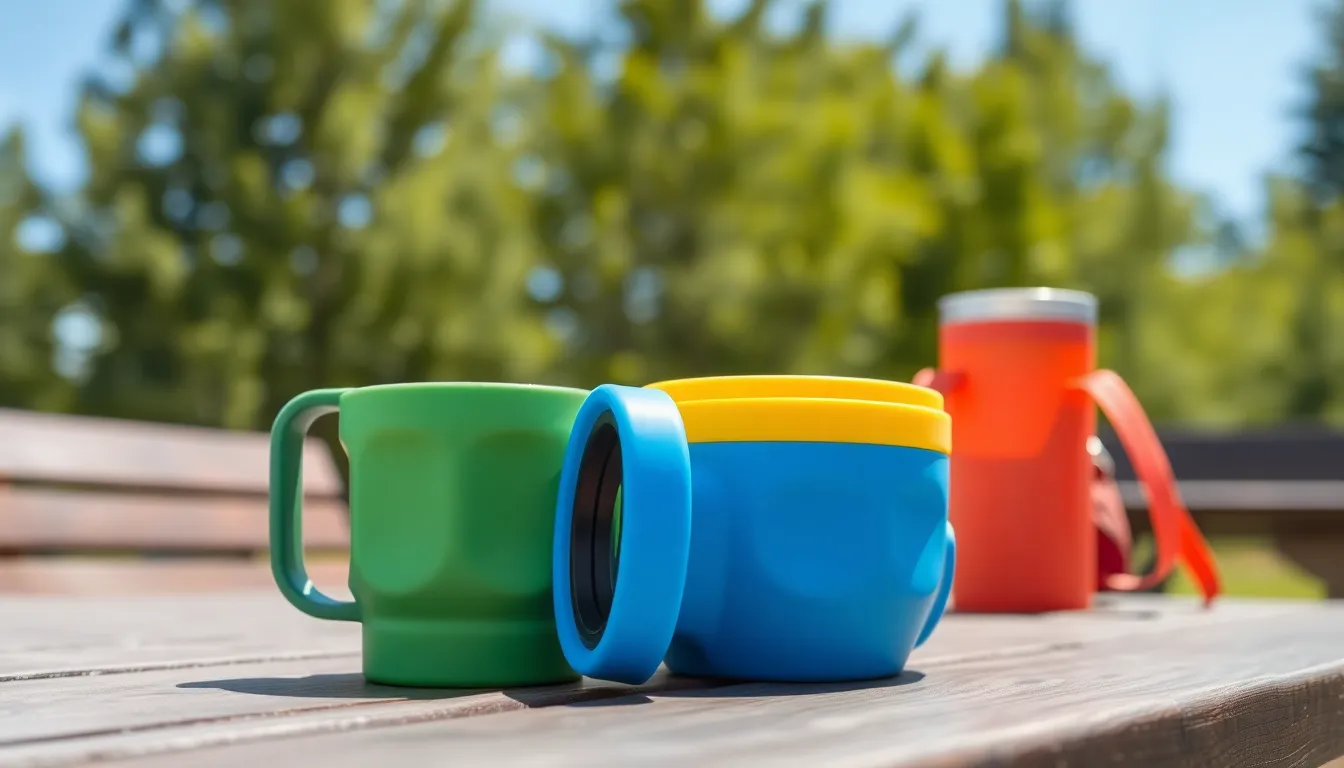
Plastic and silicone mugs offer practical answers for coffee drinkers who prioritize durability and portability. These lightweight alternatives provide distinct advantages for exact situations, particularly for outdoor activities and travel.
BPA-Free Plastic Considerations
Plastic coffee mugs are manufactured from polymers like polypropylene (PP) or polyethylene terephthalate (PET), creating lightweight and break-resistant options. Safety concerns have transformed the plastic mug market, with BPA-free materials now considered standard for health-conscious consumers. Bisphenol A (BPA) has been linked to potential health risks, prompting manufacturers to clearly label their products as BPA-free. Quality plastic mugs maintain temperature adequately while offering exceptional durability compared to ceramic or glass options.
The drawbacks of plastic mugs include relatively poor heat retention compared to ceramic alternatives. Off-flavors can sometimes develop in beverages served in lower-quality plastic vessels, affecting the taste experience. Environmental impact remains a important concern with plastic products, as they’re typically less eco-friendly than materials like ceramic or metal.
Silicone Mug Benefits
Silicone mugs combine flexibility with impressive heat resistance, making them increasingly popular for travelers and outdoor enthusiasts. The flexible nature of silicone allows for collapsible designs that save storage space when not in use. Many silicone mugs incorporate innovative features like folding handles or compressible bodies that expand to full size when needed.
Heat resistance ranks among silicone’s most valuable properties, handling hot beverages without degrading or releasing harmful chemicals. Durability gives silicone mugs an edge for rough conditions where ceramic would likely break. Temperature retention falls somewhat short compared to insulated metal options, though some designs incorporate additional insulating features to improve performance.
Silicone products resist staining and typically don’t retain flavors from previous beverages, creating a more consistent taste experience. Cleaning proves remarkably simple as most silicone mugs can be placed in dishwashers without damage concerns.
Eco-Friendly Coffee Mug Materials
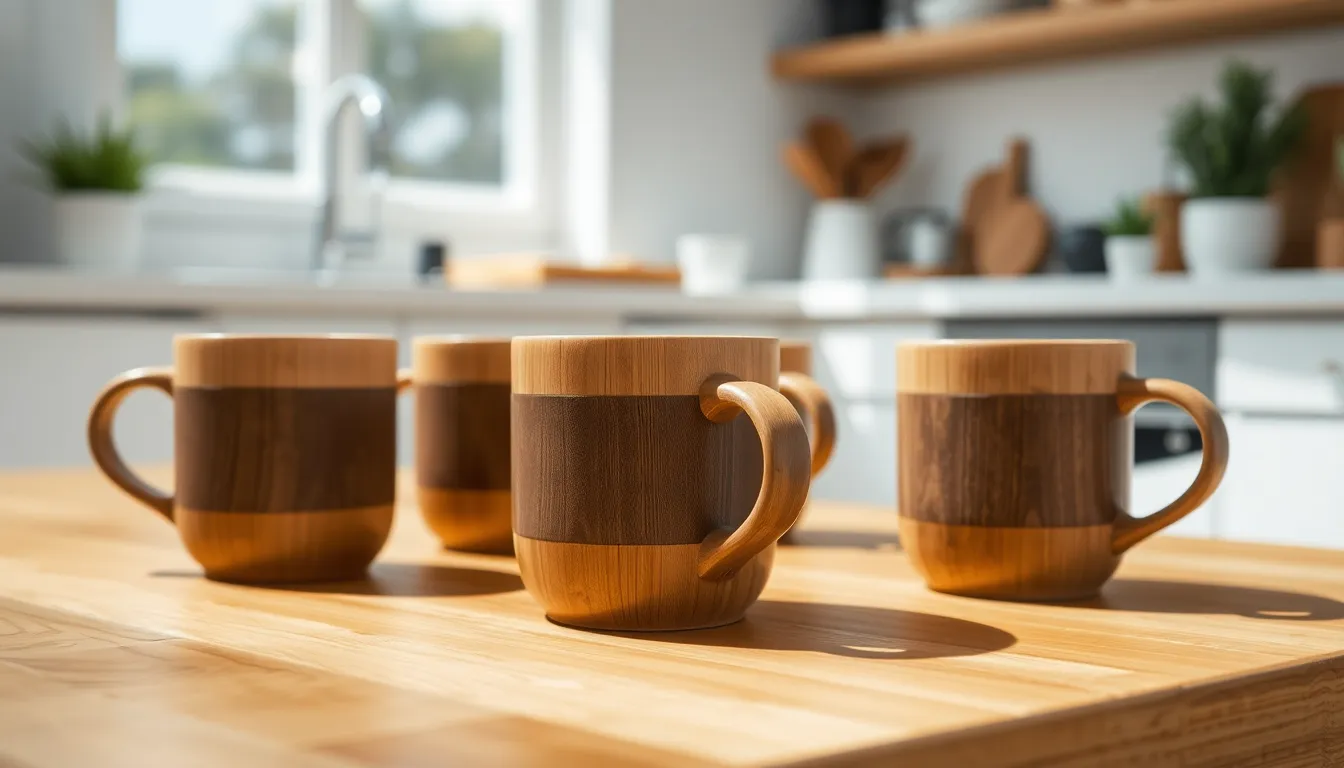
Eco-friendly coffee mugs offer sustainable alternatives to traditional materials, combining environmental consciousness with functionality. These innovative options reduce environmental impact while still delivering a quality coffee drinking experience.
Bamboo Fiber Mugs
Bamboo fiber represents a truly renewable resource in the coffee mug market. These lightweight mugs combine natural bamboo fibers with biodegradable components to create vessels that feel good in your hands and on your conscience. The renewable nature of bamboo—growing up to 3 feet per day in ideal conditions—makes it an exceptional sustainable material choice. Bamboo fiber mugs typically compost naturally at the end of their lifecycle, unlike traditional ceramic or plastic options that may persist in landfills for centuries. Their light weight makes them perfect for coffee on the go, while their natural appearance adds an organic aesthetic to your morning routine.
Recycled and Biodegradable Options
Recycled materials have transformed the coffee mug industry with innovative answers that give waste products new life. Paper composites with biodegradable linings offer a promising alternative to conventional mugs, though the polyethylene layers in many paper cups create recycling challenges. New advancements include fully biodegradable cups and mugs that break down naturally after disposal. Some manufacturers now create mugs from recycled plastics diverted from oceans and landfills, giving these materials a second purpose while reducing environmental impact. Bioplastics derived from corn, sugarcane, and other plant materials provide another eco-conscious option, offering similar performance to traditional plastics without the long-term environmental consequences.
| Material Type | Biodegradability | Recyclability | Environmental Impact |
|---|---|---|---|
| Bamboo Fiber | High (compostable) | Limited | Very Low |
| Recycled Plastics | Low | High | Medium-Low |
| Bioplastics | Medium to High | Variable | Low |
| Paper Composites | Medium | Challenging | Medium |
How Manufacturing Processes Affect Mug Quality
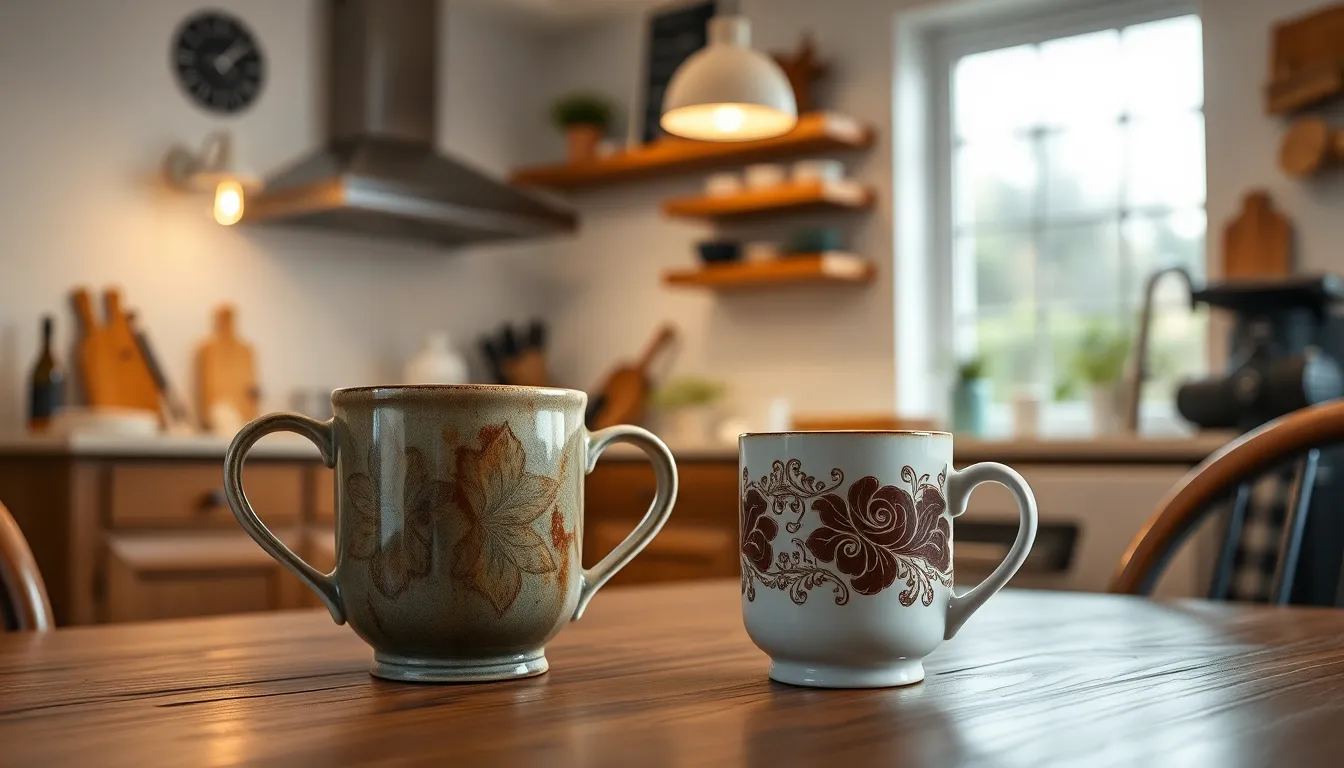
Manufacturing processes directly impact the quality, durability, and performance of coffee mugs across all material types. Each process creates distinct characteristics that enhance your coffee-drinking experience in different ways.
Ceramic and Porcelain Production
Ceramic and porcelain mugs undergo a meticulous process involving clay shaping, drying, and kiln firing. Higher firing temperatures, particularly for stoneware and porcelain varieties, significantly increase durability and resistance to chipping. The glazing process adds both aesthetic appeal and functionality by creating a smooth, waterproof surface that prevents coffee from seeping into the material. Premium ceramic mugs are fired at temperatures exceeding 2300°F, resulting in exceptional strength and longevity.
Glass Mug Formation
Glass mugs begin as molten glass that’s carefully molded into the desired shape before undergoing tempering. This crucial tempering process enhances heat resistance and substantially reduces breakage risk. Manufacturers of high-quality glass mugs, like those made from borosilicate glass, employ specialized techniques that create a product capable of withstanding extreme temperature changes without cracking or shattering.
Metal Mug Engineering
Stainless steel and other metal mugs are crafted through precise sheet shaping and welding processes. These techniques ensure lightweight yet durable products ideal for rugged conditions. Many premium metal mugs feature double-wall construction with vacuum-sealed chambers that dramatically improve insulation properties. The finishing stages often include specialized coatings that enhance both insulation performance and aesthetic appeal.
Plastic Mug Development
Plastic mugs are primarily produced through injection molding, where molten plastic is forced into molds under pressure. Advanced polymers like polypropylene (PP) are engineered specifically for heat resistance, safety, and recyclability. The manufacturing precision directly affects the mug’s structural integrity, with high-quality plastic mugs featuring consistent wall thickness and smooth finishing that prevents bacterial buildup in crevices.
Quality differences between budget and premium mugs often trace back to these manufacturing processes. The temperature precision during ceramic firing, the purity of materials in glass production, the welding quality in metal mugs, and the polymer grade in plastic options all contribute to creating mugs that maintain optimal temperature, resist damage, and provide years of reliable use.
Choosing the Right Coffee Mug Material for Your Needs
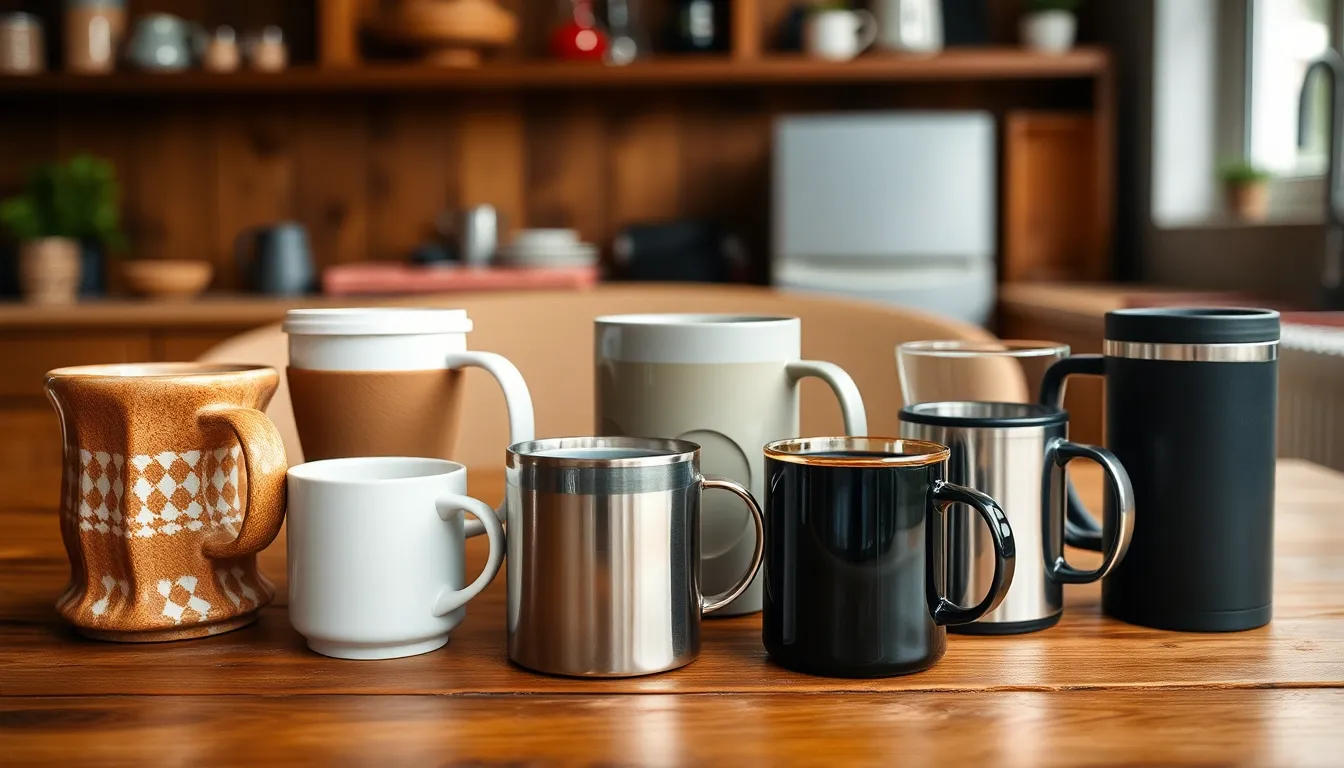
Selecting the ideal coffee mug material involves considering your exact lifestyle, preferences, and coffee-drinking habits. Each material offers distinct advantages that cater to different priorities.
For Daily Home Use
Ceramic mugs represent the perfect everyday choice for home coffee enthusiasts. Porcelain options provide excellent heat retention while offering attractive designs that enhance your morning ritual. Stoneware mugs deliver outstanding durability for daily use, withstanding frequent washing and handling without chipping. These ceramic varieties maintain your coffee’s temperature longer than glass alternatives, creating a more enjoyable drinking experience.
For Travel and On-the-Go
Stainless steel mugs excel for commuters and travelers due to their exceptional durability and insulation properties. Double-walled stainless steel options keep coffee hot for 4-6 hours, preventing spills with secure lids. Lightweight plastic mugs made from polypropylene offer break-resistant alternatives for travel, though they don’t retain heat as effectively as metal options. Their lightweight nature makes them ideal for backpacking or situations where every ounce matters.
For Temperature Retention
Insulated stainless steel mugs maintain beverage temperatures longer than any other material. These mugs feature vacuum-sealed double walls that prevent heat transfer, keeping hot drinks hot for hours. Thick ceramic mugs also perform admirably, holding heat significantly better than thin glass or plastic options. The material thickness directly affects how long your coffee stays at the optimal drinking temperature.
For Flavor Preservation
Glass mugs preserve coffee flavor perfectly as they don’t impart any additional taste to your brew. Their non-porous surface prevents absorption of coffee oils or residual flavors from previous drinks. High-quality porcelain mugs similarly maintain flavor integrity without introducing unwanted tastes. These materials prove especially important for specialty coffee drinkers who want to experience the full flavor profile of their beans.
For Eco-Conscious Consumers
Ceramic mugs offer longevity and recyclability, making them environmentally responsible choices. Stainless steel options provide exceptional durability and can last decades with proper care. Plastic mugs made from recycled materials or biodegradable plastics reduce environmental impact when compared to disposable cups. The most eco-friendly choice remains the mug you already own and continue to use rather than purchasing new ones frequently.
For Health and Safety
Porcelain and stoneware mugs contain no harmful chemicals that might leach into hot beverages. Food-grade stainless steel provides a safe, non-reactive surface for hot drinks without concerning compounds. When choosing plastic mugs, look specifically for BPA-free polypropylene options that withstand heat without releasing toxins. These safety considerations become particularly important for daily coffee drinkers concerned about long-term exposure to potentially harmful substances.
Conclusion
Your coffee mug is more than just a vessel—it’s a carefully designed tool that impacts your entire drinking experience. From classic ceramic to innovative eco-friendly materials each option offers unique benefits for temperature control taste preservation and durability.
By selecting the right material for your needs you’ll enhance your daily coffee ritual. Whether you prioritize heat retention with ceramic sustainability with bamboo or portability with stainless steel the perfect mug awaits.
Remember that quality manufacturing processes matter just as much as the material itself. Investing in a well-crafted mug means enjoying your favorite brew exactly as intended every single time—making that perfect cup of coffee even more satisfying.
Frequently Asked Questions
What materials are best for coffee mugs?
Ceramic, porcelain, stainless steel, and glass are among the best materials for coffee mugs. Ceramic and porcelain offer excellent heat retention and don’t affect taste. Stainless steel provides superior insulation, making it ideal for travel. Glass mugs offer visual appeal and pure taste. The best material depends on your specific needs—consider factors like heat retention, durability, and whether you’ll use it at home or on-the-go.
How do ceramic and porcelain mugs differ?
Ceramic mugs are practical, durable, and can be personalized with various glazes and decorations. Porcelain mugs are more refined with a translucent appearance, offering elegance but typically at a higher price point. Porcelain tends to be heavier than ceramic but both materials provide excellent heat retention and don’t affect coffee flavor. Ceramic is generally more affordable and casual, while porcelain is considered more upscale.
Why choose glass coffee mugs?
Glass coffee mugs offer elegant transparency that allows you to appreciate your coffee’s color and clarity. Premium borosilicate glass provides exceptional heat resistance, withstanding temperature extremes without cracking. Glass doesn’t impart any flavors to your coffee, ensuring a pure taste experience. While they may be more fragile than other materials, quality glass mugs provide visual temperature indicators and aesthetic appeal that many coffee enthusiasts value.
Are stainless steel mugs good for coffee?
Yes, stainless steel mugs excel for coffee, especially for travel use. They offer exceptional durability, superior insulation (especially with double-wall construction), and resist rust and corrosion. They’re easy to clean and maintain temperature far longer than ceramic or glass options. While they don’t showcase the coffee visually, they’re practically unbreakable and ideal for commuting. The only drawback is some people report a slight metallic taste with certain brews.
What are the benefits of eco-friendly coffee mugs?
Eco-friendly coffee mugs reduce environmental impact while maintaining functionality. Bamboo fiber mugs are renewable, compostable, and biodegradable. Recycled and biodegradable options like paper composites and bioplastics offer innovative alternatives to traditional materials. These sustainable options minimize waste and carbon footprint. Additionally, durable materials like ceramic and stainless steel are eco-friendly due to their longevity, reducing the need for frequent replacements.
Do different mug materials affect coffee taste?
Yes, mug materials can affect coffee taste. Glass and high-quality porcelain are neutral and don’t impart additional flavors. Ceramic is generally neutral but some glazes might affect taste subtly. Metal mugs, particularly lower-quality ones, can sometimes add a slight metallic taste. Plastic mugs may leach chemicals or retain flavors from previous uses. For the purest coffee experience, opt for glass, porcelain, or high-quality ceramic mugs.
How does manufacturing process affect mug quality?
Manufacturing processes significantly impact mug quality, durability, and performance. Ceramic and porcelain mugs require high firing temperatures and proper glazing for durability. Glass mugs undergo tempering to enhance heat resistance. Metal mugs need precise shaping and welding for optimal insulation. Quality differences between budget and premium mugs often trace back to these manufacturing processes, affecting temperature maintenance and resistance to damage or wear over time.
What’s the most durable coffee mug material?
Stainless steel is the most durable coffee mug material, being virtually unbreakable and resistant to rust, corrosion, and staining. It withstands drops, temperature fluctuations, and daily use without degrading. High-fired stoneware is the most durable ceramic option, resisting chips better than standard ceramic or porcelain. For those concerned about durability, silicone and quality plastic options are also highly resilient, though they may not maintain heat as effectively.
Are plastic coffee mugs safe to use?
Modern plastic coffee mugs made from BPA-free materials like polypropylene and PET are generally safe for cold to warm beverages. However, avoid using them with extremely hot liquids, which can potentially cause chemicals to leach into your drink. Look for mugs explicitly labeled “food-grade” and “BPA-free.” For daily hot coffee consumption, ceramic, glass, or stainless steel options are typically recommended as safer alternatives that don’t risk chemical transfer.
What coffee mug material retains heat the longest?
Double-walled stainless steel mugs with vacuum insulation retain heat the longest, keeping coffee hot for 4-6 hours or more. Ceramic and porcelain mugs with thick walls offer good heat retention for about 20-30 minutes. Stoneware performs similarly to ceramic but may hold heat slightly longer due to its density. Glass and thin plastic have the poorest heat retention. For maximum temperature maintenance, insulated metal mugs are unmatched.

